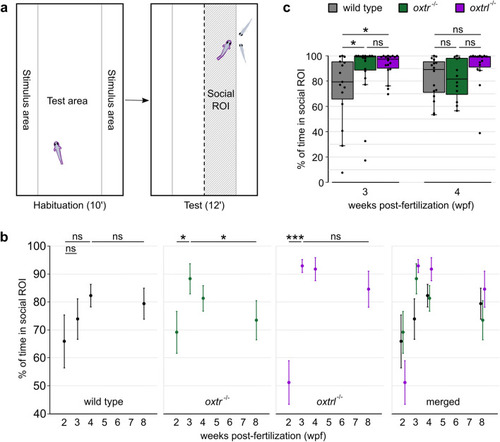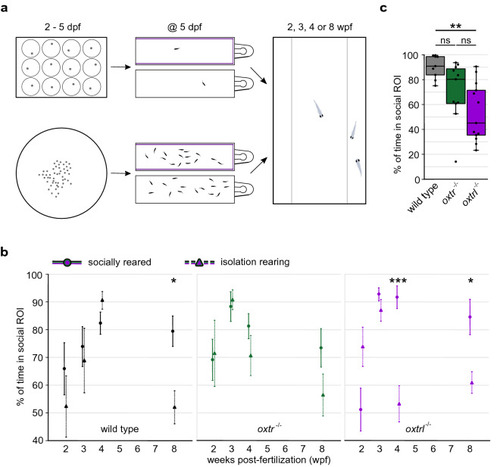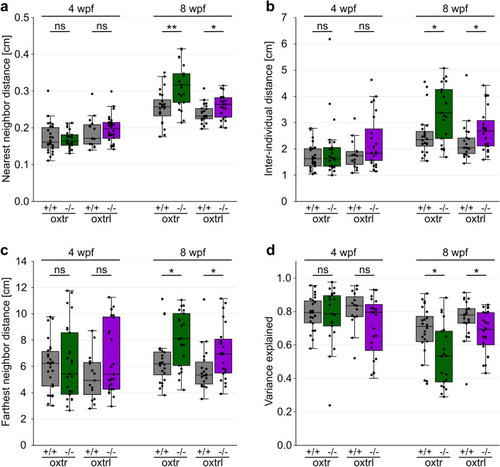- Title
-
Oxytocin receptors influence the development and maintenance of social behavior in zebrafish (Danio rerio)
- Authors
- Gemmer, A., Mirkes, K., Anneser, L., Eilers, T., Kibat, C., Mathuru, A., Ryu, S., Schuman, E.
- Source
- Full text @ Sci. Rep.
|
Oxytocin receptors affect the development, intensity and maintenance of social preference. ( PHENOTYPE:
|
|
Isolation rearing impairs the maintenance, but not the development of social preference. ( PHENOTYPE:
|
|
Shoal cohesion and polarization is positively influenced by the Oxytocin receptors at 8 wpf. (a) The absence of either Oxytocin receptor led to increased nearest neighbor distance at 8 wpf, but not at 4 wpf. n for shoals: see below. Kruskal–Wallis-Test for nearest-neighbor distance: p(4wpf) = 1.69 × 10−2, p(8wpf) = 4.72 × 10−5, Wilcoxon rank-sum test for the nearest-neighbor distance of wild-type vs. mutant genotype: p(oxtr+/+⇔oxtr−/−, 4wpf) = 4.74 × 10−1, p(oxtrl+/+⇔oxtrl−/−, 4wpf) = 3.17 × 10−1, p(oxtr+/+⇔oxtr−/−, 8wpf) = 1.64 × 10−3, p(oxtrl +/+⇔oxtrl−/−, 8wpf) = 4.13 × 10−2. (b) The inter-individual distance was enlarged in both Oxytocin receptor KO lines at 8 wpf, but not at 4 wpf. n for shoals: see below. Kruskal–Wallis-Test for inter-individual distance: p(4wpf) = 2.07 × 10−1, p(8wpf) = 2.40 × 10−3, Wilcoxon rank-sum test for the inter-individual distance of wild-type vs. mutant genotype: p(oxtr+/+⇔oxtr−/−, 4wpf) = 4.09 × 10−1, p(oxtrl+/+⇔oxtrl−/−, 4wpf) = 2.59 × 10−1, p(oxtr+/+⇔oxtr−/−, 8wpf) = 1.38 × 10−2, p(oxtrl+/+⇔oxtrl−/−, 8wpf) = 2.01 × 10−2. (c) oxtr−/− and oxtrl−/−showed increased farthest neighbor distance at 8 wpf, but not at 4 wpf. n for shoals: see below. Kruskal–Wallis-Test for farthest-neighbor distance: p(4wpf) = 4.79 × 10−1, p(8wpf) = 2.65 × 10−3, Wilcoxon rank-sum test for the farthest-neighbor distance of wild-type vs. mutant genotype: p(oxtr+/+⇔oxtr−/−, 4wpf) = 4.74 × 10−1, p(oxtrl+/+⇔oxtrl−/−, 4wpf) = 1.29 × 10−1, p(oxtr+/+⇔oxtr−/−, 8wpf) = 1.91 × 10−2, p(oxtrl+/+⇔oxtrl−/−, 8wpf) = 1.91 × 10−2. (d) Coordinated swimming, represented by the variance explained, was reduced in both knockout groups at 8 wpf but remained unaffected at 4 wpf. n for shoals: see below. Kruskal–Wallis-Test for variance explained: p(4wpf) = 5.64 × 10−1, p(8wpf) = 7.00 × 10−4, Wilcoxon rank-sum test for the variance explained of wild-type vs. mutant genotype: p(oxtr+/+⇔oxtr−/−, 4wpf) = 8.88 × 10−1, p(oxtrl+/+⇔oxtrl−/−, 4wpf) = 4.80 × 10−1, p(oxtr+/+⇔oxtr−/−, 8wpf) = 4.95 × 10−2, p(oxtrl+/+⇔oxtrl−/−, 8wpf) = 4.95 × 10−2. Number of shoals (containing 20 fish each) per group: n(oxtr+/+, 4wpf) = 26, n(oxtr−/−, 4wpf) = 25, n(oxtrl+/+, 4wpf) = 15, n(oxtrl−/−, 4wpf) = 28, n(oxtr+/+, 8wpf) = 24, n(oxtr−/−, 8wpf) = 21, n(oxtrl+/+, 8wpf) = 22, n(oxtrl−/−, 8wpf) = 23. Each dot represents one shoal. Asterisks represent the statistical comparison between mutant and wild-type genotype at different ages. Number of replicates (n) and excluded n can be found in Supplementary Table S1, significance values in Supplementary Table S2. Significance is reported as *p < 0.05, **p < 0.01, ***p < 0.001. PHENOTYPE:
|



